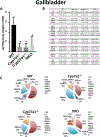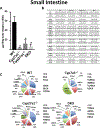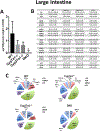Bile Acid Homeostasis in a Cholesterol 7α-Hydroxylase and Sterol 27-Hydroxylase Double Knockout Mouse Model
- PMID: 30864232
- PMCID: PMC7893641
- DOI: 10.1002/hep.30612
Bile Acid Homeostasis in a Cholesterol 7α-Hydroxylase and Sterol 27-Hydroxylase Double Knockout Mouse Model
Abstract
Bile acids (BAs) are diverse molecules that are synthesized from cholesterol in the liver. The synthesis of BAs has traditionally been shown to occur through two pathways. Cholesterol 7α-hydroxylase (CYP7A1) performs the initial and rate-limiting step in the classical pathway, and sterol 27-hydroxylase (CYP27A1) initiates the hydroxylation of cholesterol in the alternative pathway. While the role of individual BA species as physiological detergents is relatively ubiquitous, their endocrine functions as signaling molecules and roles in disease pathogenesis have been emerging to be BA species-specific. In order to better understand the pharmacologic and toxicologic roles of individual BA species in an in vivo model, we created cholesterol 7α-hydroxylase (Cyp7a1) and sterol 27-hydroxylase (Cyp27a1) double knockout (DKO) mice by cross-breeding single knockout mice (Cyp7a1-/- and Cyp27a1-/- ). BA profiling and quantification by liquid chromatography-mass spectrometry of serum, gallbladder, liver, small intestine, and colon of wild-type, Cyp7a1-/- , Cyp27a1-/- , and DKO mice showed that DKO mice exhibited a reduction of BAs in the plasma (45.9%), liver (60.2%), gallbladder (76.3%), small intestine (88.7%), and colon (93.6%), while maintaining a similar BA pool composition compared to wild-type mice. The function of the farnesoid X receptor (FXR) in DKO mice was lower, revealed by decreased mRNA expression of well-known FXR target genes, hepatic small heterodimer partner, and ileal fibroblast growth factor 15. However, response to FXR synthetic ligands was maintained in DKO mice as treatment with GW4064 resulted in similar changes in gene expression in all strains of mice. Conclusion: We provide a useful tool for studying the role of individual BAs in vivo; DKO mice have a significantly reduced BA pool, have a similar BA profile, and maintained response to FXR activation.
© 2019 by the American Association for the Study of Liver Diseases.
Figures








Similar articles
-
Bile acid homeostasis in female mice deficient in Cyp7a1 and Cyp27a1.Acta Pharm Sin B. 2021 Dec;11(12):3847-3856. doi: 10.1016/j.apsb.2021.05.023. Epub 2021 May 26. Acta Pharm Sin B. 2021. PMID: 35024311 Free PMC article.
-
FXR agonist GW4064 improves liver and intestinal pathology and alters bile acid metabolism in rats undergoing small intestinal resection.Am J Physiol Gastrointest Liver Physiol. 2019 Aug 1;317(2):G108-G115. doi: 10.1152/ajpgi.00356.2017. Epub 2019 Mar 28. Am J Physiol Gastrointest Liver Physiol. 2019. PMID: 30920307
-
Characterization of individual bile acids in vivo utilizing a novel low bile acid mouse model.Toxicol Sci. 2024 May 28;199(2):316-331. doi: 10.1093/toxsci/kfae029. Toxicol Sci. 2024. PMID: 38526215 Free PMC article.
-
Triglycerides and gallstone formation.Clin Chim Acta. 2010 Nov 11;411(21-22):1625-31. doi: 10.1016/j.cca.2010.08.003. Epub 2010 Aug 10. Clin Chim Acta. 2010. PMID: 20699090 Review.
-
Farnesoid X receptor, the bile acid sensing nuclear receptor, in liver regeneration.Acta Pharm Sin B. 2015 Mar;5(2):93-8. doi: 10.1016/j.apsb.2015.01.005. Epub 2015 Feb 20. Acta Pharm Sin B. 2015. PMID: 26579433 Free PMC article. Review.
Cited by
-
Biochanin A Regulates Cholesterol Metabolism Further Delays the Progression of Nonalcoholic Fatty Liver Disease.Diabetes Metab Syndr Obes. 2021 Jul 9;14:3161-3172. doi: 10.2147/DMSO.S315471. eCollection 2021. Diabetes Metab Syndr Obes. 2021. PMID: 34276221 Free PMC article.
-
Dendrobium nobile Lindl. alkaloids improve lipid metabolism by increasing LDL uptake through regulation of the LXRα/IDOL/LDLR pathway and inhibition of PCSK9 expression in HepG2 cells.Exp Ther Med. 2025 Jan 9;29(3):46. doi: 10.3892/etm.2025.12796. eCollection 2025 Mar. Exp Ther Med. 2025. PMID: 39885913 Free PMC article.
-
Cholesterol-binding translocator protein TSPO regulates steatosis and bile acid synthesis in nonalcoholic fatty liver disease.iScience. 2021 May 1;24(5):102457. doi: 10.1016/j.isci.2021.102457. eCollection 2021 May 21. iScience. 2021. PMID: 34013171 Free PMC article.
-
Bile acid synthesis impedes tumor-specific T cell responses during liver cancer.Science. 2025 Jan 10;387(6730):192-201. doi: 10.1126/science.adl4100. Epub 2025 Jan 9. Science. 2025. PMID: 39787217
-
Bile acid receptors FXR and TGR5 signaling in fatty liver diseases and therapy.Am J Physiol Gastrointest Liver Physiol. 2020 Mar 1;318(3):G554-G573. doi: 10.1152/ajpgi.00223.2019. Epub 2020 Jan 27. Am J Physiol Gastrointest Liver Physiol. 2020. PMID: 31984784 Free PMC article. Review.
References
Publication types
MeSH terms
Substances
Grants and funding
LinkOut - more resources
Full Text Sources

